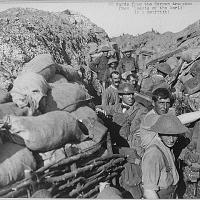
When Sitting in the Trenches is not Enough
Today, as promised I will look at the positions that the readers posted. Two positions were similar in that one side had a material advantage but had trouble finding a winning plan. It is very hard to win a winning position. It is hard from a psychological point of view: one has to stay calm and forget about a point in the crosstable. One can get too relaxed and miss some resources that the opponent prepared. Naturally, when one feels that one is losing a game one tends to maximize one's output, try harder to hold the game. Thus the winning side gets relaxed, the losing side puts extra effort and as a result many winning games end in a draw or in reverse results. So, one way to play positions with extra material is to stay cool and to play with a plan. I hear many times even experienced GMs say “ I was waiting until the opponent would collapse.” And guess what? The defenders didn’t collapse. Waiting can be good in some situations but in many cases one has to have a plan to improve the position. The following two examples are good illustrations of a situation where a side has a strong advantage but it can evaporate if one will not find an active plan of realizing that advantage.
Let us start by evaluating the position. Black is up a pawn but the white pieces are active. Black particularly has a bad Bishop on e6, has control of the open c-file but at the same time a weakness on a6. All the black pawns on the queenside are on light squares- the same as his bishop, which makes the bishop even worse. The presence of opposite color bishops on the board makes the endgames hard to win. If queens get traded white can always defend by offering rook exchanges. At the same time black would have to put the rook on the worse position in order not to exchange it. It is a common knowledge that opposite colors endgames in the most cases are drawn. In this position black probably will get a passed pawn on the queenside but if the pieces get traded in a bishop endgame white can use a bishop to block “b” pawn and a king to block “d” pawn with a draw. The first plan that came into mind is to use the “c” file to create threats. White will put the queen on d2 and a rook on d1, king on h2 and it is extremely hard to break through. The other setup that is possible is to exchange queens and try to attack the a3 pawn with the rook. But white will play Rc3, threatening a rook exchange, capturing the open file, and protecting the a3 pawn. In all of these lines white absolutely must play f4 to protect the e5 pawn and to block the bishop on e6.
One has to remember that in the middlegame opposite colored bishops can be a great strength… when one attacks the king. If we look at this position, what we notice is Qa5 and Bd4 are away from the white king, while black pieces can easily regroup to attack the king. Thus the solution and the plan comes right away. 1…f4! Opens the bishop, creates a threat of f3 with further attack and does not allow white to play f4 himself. Thus the move is multifunctional and extremely strong.
In the next position white is up in material – a bishop for two pawns. The black rooks are passive, the white rooks are more active. Bf6 interrupts the black coordination. How to find a plan? We can try typical methods: find a weakness and attack it, improve our pieces, improve our pawn structure, if these do not work then create more weaknesses in the black camp. The obvious weakness is on a5 but it will take a long time to attack it: Rc1-Rc5-Ra5. It is too long – black has time to activate his rook by taking the b-file and the weakness of the first rank makes the position close to equality. How to improve our pieces? One obvious way is to put a bishop on d6, from there it will take away the very important square b8, from which black rooks can control the b-file. It is too slow again! Black has counterplay by undermining the e5 pawn with f6. There is a plan in improving pawn structure with g3-h4 but this does not create any threats. Now, we have to look at undermining the black pawns with the f3 move. It has several purposes: threatens to open the position with f:e4, opens a window for the white king. This move makes sense from a point of view if we see that the black e4-pawn takes too much space in the center and if we destroy the pawn our pawn on e5 can create an open file after Re1-e6 for example.
I would like to give two positions to solve for the next week. Both of them are from the recent practice of Kramnik. When one hears the last name Kramnik one has associations with deep positional planning, amazing feel for position and super technique…






